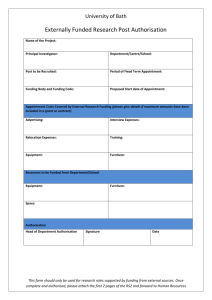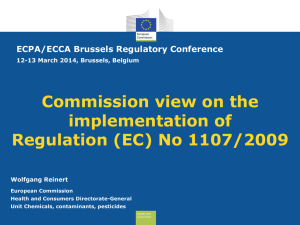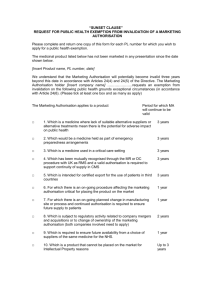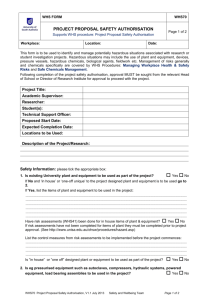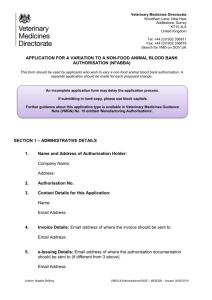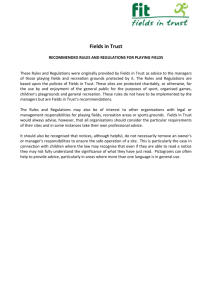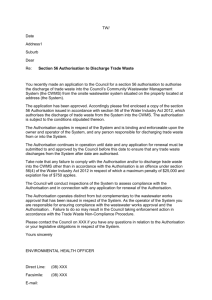Explanation Form G-ZRMS
advertisement
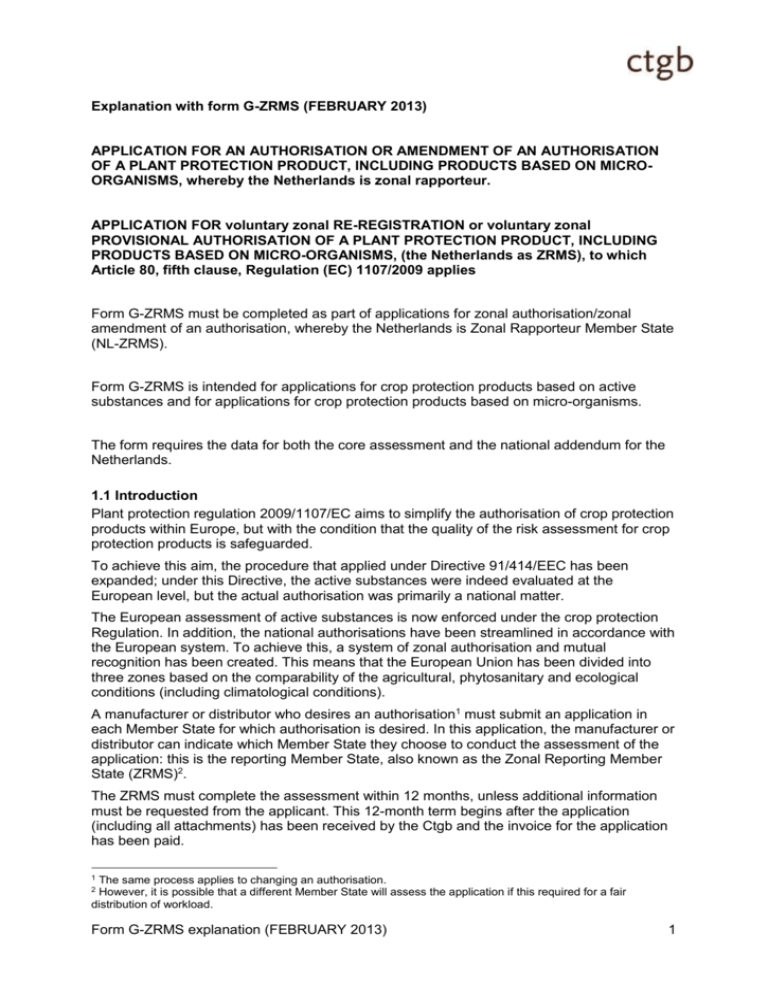
Explanation with form G-ZRMS (FEBRUARY 2013) APPLICATION FOR AN AUTHORISATION OR AMENDMENT OF AN AUTHORISATION OF A PLANT PROTECTION PRODUCT, INCLUDING PRODUCTS BASED ON MICROORGANISMS, whereby the Netherlands is zonal rapporteur. APPLICATION FOR voluntary zonal RE-REGISTRATION or voluntary zonal PROVISIONAL AUTHORISATION OF A PLANT PROTECTION PRODUCT, INCLUDING PRODUCTS BASED ON MICRO-ORGANISMS, (the Netherlands as ZRMS), to which Article 80, fifth clause, Regulation (EC) 1107/2009 applies Form G-ZRMS must be completed as part of applications for zonal authorisation/zonal amendment of an authorisation, whereby the Netherlands is Zonal Rapporteur Member State (NL-ZRMS). Form G-ZRMS is intended for applications for crop protection products based on active substances and for applications for crop protection products based on micro-organisms. The form requires the data for both the core assessment and the national addendum for the Netherlands. 1.1 Introduction Plant protection regulation 2009/1107/EC aims to simplify the authorisation of crop protection products within Europe, but with the condition that the quality of the risk assessment for crop protection products is safeguarded. To achieve this aim, the procedure that applied under Directive 91/414/EEC has been expanded; under this Directive, the active substances were indeed evaluated at the European level, but the actual authorisation was primarily a national matter. The European assessment of active substances is now enforced under the crop protection Regulation. In addition, the national authorisations have been streamlined in accordance with the European system. To achieve this, a system of zonal authorisation and mutual recognition has been created. This means that the European Union has been divided into three zones based on the comparability of the agricultural, phytosanitary and ecological conditions (including climatological conditions). A manufacturer or distributor who desires an authorisation1 must submit an application in each Member State for which authorisation is desired. In this application, the manufacturer or distributor can indicate which Member State they choose to conduct the assessment of the application: this is the reporting Member State, also known as the Zonal Reporting Member State (ZRMS)2. The ZRMS must complete the assessment within 12 months, unless additional information must be requested from the applicant. This 12-month term begins after the application (including all attachments) has been received by the Ctgb and the invoice for the application has been paid. 1 The same process applies to changing an authorisation. However, it is possible that a different Member State will assess the application if this required for a fair distribution of workload. 2 Form G-ZRMS explanation (FEBRUARY 2013) 1 Transitional legislation on re-registrations and provisional authorisations under the Regulation on Plant Protection Products Article 80, fifth clause, preamble and under b of Regulation 1107/2009/EC specifies which legislation applies to applications for re-registration: the old legislation of Directive 91/414/EC. Applications for re-registration of plant protection products, whereby the active substance a. has been included under Directive 91/414/EEC, or b. has been approved according to the first clause of Article 80 (= for which the application submitted under 91/414 for inclusion before 14 June 2011 was found to be complete and which has led to approval based on the provisions in the first clause of Article 80), will be assessed according to the Dutch law in effect under 91/414/EEC. This also means that the core assessment procedure (as described in Articles 33 to 39 of the Regulation) does not apply. Therefore, applications for re-registration, if they meet the above requirements, will in principle be processed 'nationally'. The foregoing also applies to the provisional authorisation of plant protection products based on active substances for which an application for inclusion in Annex I of Directive 91/414/EEC was declared to be complete before 14 June 2011. Is there a zonal option for re-registrations and provisional authorisations? Before 14 June 2011, there was an option for the application to be handled in the zonal structure. In this context this means that within the zone a single Member State takes on the reporting role and that the other Member States take over the assessment of the 'rapporteur' as much as possible. However, this emphatically does not mean that the Regulation applies in substantive and procedural terms; in those cases, the legal framework (at both the national and European level) continues to be that of Directive 91/414/EEC. For example, the deadlines of the Regulation do not apply. The advantage is that the applicant can spend more time answering any supplementary questions. Which form is used for applications for re-registration and provisional authorisation? For an application for voluntary zonal re-registration/provisional authorisation of a plant protection product, you must use form G/M-ZRMS (APRIL 2012). This version includes the option of indicating that this is a voluntary zonal re-registration/provisional authorisation. For an application for a non-zonal re-registration/provisional authorisation of a plant protection product (application solely for the Netherlands) you must use form G Transitional legislation (FEBRUARY 2013). 1.2 Zonal authorisation of plant protection products for use in greenhouses, postharvest treatment, treatment of empty storage rooms or seed treatment The plant protection products from these categories are handled inter-zonally: for all zones together there is only one Reporting Member State. Form G-ZRMS explanation (FEBRUARY 2013) 2 THE APPLICATION PROCESS FOR ZONAL AUTHORISATION (NL-ZRMS) 2.1 Announcing the zonal application At least six months before the application is to be submitted, the applicant is expected to make an appointment with the desired ZRMS (see the Ctgb website under 'Application procedure for products’). The notification form for zonal applications must be filled in (see Ctgb website, under 'Zonal application'). This form must include all national uses (GAP/Table of uses) for all Member States in which authorisation is requested, and the risk envelope must be filled in. The notification form must be sent to every Member State in which authorisation will be requested. If the Netherlands is proposed as ZRMS, the Ctgb (in consultation with the applicant) will determine when the application can be assessed by the Netherlands. 2.2 The pre-submission meeting Compared to the situation under the Directive, during the application procedure under the plant protection Regulation, if the dossier that has been supplied cannot lead directly to authorisation, there will be many fewer opportunities to supplement applications that are not complete, or to ask additional questions. To prevent this from leading to the rejection or declaration of inadmissibility of applications which otherwise would have been approved, the Ctgb holds a pre-submission meeting after a manufacturer or distributor reports to the Ctgb that they plan to submit an application in which the Ctgb is indicated as ZRMS. To prepare for the pre-submission meeting, the candidate-applicant must submit a draft application and dossier and pay an initial invoice for the costs of the meeting. During the pre-submission meeting, the participants discuss whether the application and dossier appear to be complete and if anything is needed before submitting an application that is likely to be approved. In addition, the submitted GAP table (Tables of uses) and the proposed risk envelope are discussed. The Ctgb provides the candidate applicant with a written report of the pre-submission meeting. 2.3 Submit dossier with a zonal application When submitting a zonal application, all documentation (application form, dRR, studies, etc.) will be sent to all Member states within the central zone. This is necessary because the Member States must be able to view these documents during the commentary round. Any documents that are submitted later must also be sent to all Member States within the central zone. An exception applies to the national addenda; these must be sent only to the Member State concerned. 2.4 Completeness assessment of the zonal application Initially, the ZRMS evaluates whether the application is complete, or if data are still missing. If the latter is the case, the applicant is given a maximum of 1 month to supply the missing data. During this time, the 12-month period that the ZRMS has for assessment is suspended (the total suspension term/‘stop the clock’ for an application is no more than 6 months). If the requested information is not provided, or is not provided on time, the ZRMS declares the application inadmissible. This decision is reported to the applicant, and the other Member States in the zone are notified. Form G-ZRMS explanation (FEBRUARY 2013) 3 2.5 Substantive assessment If the application is complete, the ZRMS assesses the application and checks the draft Registration Report (dRR) prepared by the applicant, which includes the core assessment and the national addendum (assessment of Netherlands-specific aspects). During the assessment, if it turns out that additional data are required, the applicant will be given a maximum of 6 months to provide this data (the total suspension term/‘stop the clock’ for an application is no more than 6 months). If the requested information is not provided, or is not provided on time, the ZRMS declares the application inadmissible. This decision is reported to the applicant, and the other Member States in the zone are notified. The ZRMS gives all Member States in the zone an opportunity (on T = at the latest 8 months) to submit written comments. Taking these comments into account, the definitive Registration Report (RR) and the decision on authorisation in the Netherlands are finalised and made accessible to all other Member States of the zone. 2.6 Authorisation by other Member States Other Member States from the zone in which applications for authorisation of the same plant protection product have been submitted then decide within 120 days after receiving the decision from the reporting Member State if they are going to authorise the product. MINOR USES AS REFERRED TO IN ARTICLE 51 REGULATION (EC) 1107/2009 Extended authorisations for minor uses can be granted if the proposed use is indeed minor and the extension is in the general interest. The definition of ‘minor use’ is set down in Article 3.26 of the Regulation: ‘minor use’: the use of a plant protection product in a particular Member State on plants or plant products which are: a) not widely grown in that Member State, or b) are widely grown, to meet an exceptional plant protection need. Minor uses of plant protection products The Netherlands distinguishes three scenarios for requesting for an authorisation for minor uses. To determine whether the intended authorisation can be considered a minor use, see the decision tree on the Ctgb website under 'Minor uses'. Note that the decision tree applies only to the Netherlands! The basic principle is to request a zonal assessment for minor uses where possible. Scenario I Request for authorisation of a new product, including minor uses (zonal assessment) When applying for a new zonal authorisation (new plant protection product), the Netherlands prefers that the GAP contains all intended uses, including the minor uses. As a result, the minor uses will be assessed zonally. Where possible – for example if it turns out that a dossier is available after all – it is desirable to attempt to assess efficacy, even if this is done by extrapolation. This will allow the assessment to also be used later on in Member States where it applies to a major use. Member States that always want the efficacy to be assessed can consider this to be a specific national matter. Scenario II Application to extend an authorisation with minor uses for multiple Member States in the zone (zonal assessment) Form G-ZRMS explanation (FEBRUARY 2013) 4 With a request to extend an authorisation with minor uses in multiple countries, a zonal assessment is the starting point. Scenario III Application to extend an authorisation with minor uses solely in the Netherlands (zonal assessment or non-zonal assessment) If a product has already been authorised and an extension with minor uses solely in the Netherlands is requested, this request can be assessed either zonally or non-zonally. If a zonal assessment is required, see below under zonal applications. If a non-zonal assessment is chosen, this means that other Member States cannot comment on the assessment. For this purpose, the Netherlands has developed a national-specific procedure based on Article 51. A accelerated ‘Risk Envelope Approach’ procedure can be used to obtain an extended authorisation if the extension falls within the risk envelope of the previously authorised uses and complies with the residues aspect (the previous assessment of the authorisation can be extrapolated according to Sanco 7525/VI/95, rev.9) and if there is an MRL. In cases where one or more aspects must still be assessed, a supplementary assessment will be conducted. The starting point for the above-mentioned assessment is a review according to the assessment framework (old assessment frameworks for plant protection products are no longer available from the Ctgb site but are available digitally on request) used in the most recent full assessment of the product. The advantage of this procedure is that the standard dossier requirements, also those that do not apply directly to the extension, do not have to be generated again with reference to the latest requirements. In certain situations it is not possible to review with reference to the assessment framework used in the most recent full assessment of the product. Which application form should be used for minor uses? Applications for minor uses under Scenarios I and II must use form G-ZRMS (February 2013). Applications for minor uses under Scenario III must use form NLKUG-A or NLKUG-B June 2012). These forms, and other information relating to applications for minor uses, can be found on the Ctgb website under 'Minor uses'. APPLICATION FOR MRL As part of zonal applications for authorisation, an MRL (maximum residue level) must often be derived. But an MRL derivation is often desirable separately from an application for (zonal) authorisation. To facilitate this process, an MRL application form has been developed (see Ctgb website). NETHERLANDS-SPECIFIC ASPECTS IN THE dRR The Netherlands-specific aspects are assessed in the national addendum of the RR or dRR (Registration Report or draft Registration Report). The Ctgb has adapted the guidance documents of the dRR to the situation in the Netherlands for national addenda. The Netherlands-specific aspects are reported in those guidance documents. In addition, exposure models are available that must be used for human toxicology; see the Ctgb website under 'Text of Regulation and Guidance documents'. An explanation of the Netherlandsspecific aspects is included below. Form G-ZRMS explanation (FEBRUARY 2013) 5 For crop protection products based on micro-organisms, no Netherlands-specific aspects are usually assessed (with the exception of labelling and efficacy). EXPLANATION OF NETHERLANDS-SPECIFIC ASPECTS For a number of aspects, it is assumed that they are specific for the Netherlands. For the other aspects, the Ctgb generally assumes that the conditions within the central zone are comparable for both the Netherlands and in the Member State which initially granted the authorisation; the Ctgb also assumes that these conditions were sufficiently assessed during the original authorisation. However, if the applicant demonstrates for the Netherlands-specific aspects that the relevant conditions do not differ in either the Netherlands or the Member State which assessed the original/zonal application for authorisation, then the Ctgb will, in principle, accept this assessment. For crop protection products based on micro-organisms, no Netherlands-specific aspects are usually assessed (with the exception of labelling and efficacy). Labelling Based on the evaluation, the risk assessment and the MSDS (Material Safety Data Sheets), the proposal of the applicant will be assessed and, if necessary, modified. Efficacy and Effectiveness The assessment aspect ‘Efficacy’ has been harmonised at the European level for the assessment of the active substance and the data to be provided. The Effectiveness of the product (consisting of the active substance with coformulants and adjuvants) and its efficacy are evaluated based on the agricultural, phytosanitary, ecological and climatological conditions in the region where the plant protection product will be used. This assessment uses data from European dossiers (to the extent these are provided) and data from other Member States (to the extent these are available). Analysis methods Information must be supplied about the residue analysis methods for determining residues of the active substance(s) and relevant metabolites in surface water3. In the Netherlands, for this method an LOQ of Xx µg/L (NOEC for XXX) or 0.1 µg/L (Evaluation manual 1.0) is required (the lowest applies) . Estimation of human exposure For the national addendum, the Ctgb uses different exposure models (the spreadsheet is available) for the operator than UK-POEM and the German model: 3 It follows from the decision of the Court of Appeal on Trade and Industry of 19 August 2005 (Awb 04/37 (General Administrative Law Act)) that when considering an application, the Ctgb should, on the basis of the scientific and technical knowledge and taking into account the data submitted with the application, also judge the application according to the drinking water criterion ‘surface water intended for drinking water production’. Form G-ZRMS explanation (FEBRUARY 2013) 6 Activity/Formulation Scenario mixing Liquid and loading Powder 1 Granulate2 Field spraying Spraying in greenhouses 1 2 3 4 mechanical manual mechanical manual mechanical manual mechanical upwards mechanical downwards manual upwards manual downwards manual, upwards and downwards 3 Preference for generic model dermal inhalation EUROPOEM I EUROPOEM I EUROPOEM I NL model NL model NL model NL model NL model NL model NL model NL model NL model EUROPOEM I EUROPOEM I EUROPOEM I EUROPOEM I German model 4 German model 4 UK model UK model NL greenhouse NL greenhouse model model If the product is a water soluble film formulation, a factor of 100 times lower exposure relative to a powder is used as a default. If the data about the particle size distribution and the abradability of the granulate are lacking, the model for powdered products is used with an assumption of 10% powder in the granulate. If the granulate complies with the corresponding EU requirements, a 1% powder fraction is assumed. The determination of the powder fraction is based on data provided under P02.08.6.2a (determination of substance content of granulates) and P02.08.6.3a (determination of the abrasion of granulates, i.e. attrition behaviour). In the Dutch greenhouse model, the exposure estimates for mixing/loading and application are combined (if a value is known for dermal absorption of both the concentrate and the diluted spray solution; in this case the highest value for dermal absorption is used to calculate the systemic exposure). For manual upwards spraying, the 90th percentile of the German model is used. In addition, the exposure estimate uses default values for the area treated per day, the duration of mixing/loading and the duration of application: Activity Area treated per day (ha) Duration of mixing/loading (hours) Duration of use (hours) Mechanical downwards spraying Mechanical upwards spraying Manual application, upwards and downwards, in the field or greenhouse For applications involving products in an aerosol container, the exposure of the operator is estimated by using ConsExpo. To determine the exposure of bystanders and other workers, the Ctgb uses EUROPOEM II for the national addendum. To determine exposure from re-entry to treated lawns and sports fields, the Ctgb uses the ‘RIVM re-entry model’ for the national addendum. To determine exposure of nearby residents of greenhouses, the Ctgb uses the ‘recirculation zone’ model. Form G-ZRMS explanation (FEBRUARY 2013) 7 Public health – criteria for residues in succession crops The assessment of residues in succession crops is performed nationally if this has not been adequately assessed at the European level. A European guideline is available for assessing residues in succession crops. Annexes II and III of Directive 91/414/EC (in accordance with Article 33 clauses 2 and 3 of Regulation (EC) 1107/2009) specify the dossier requirements. However, these dossier requirements do not have clear criteria regarding situations where residues in succession crops must be assessed. For the evaluation of this data and for the corresponding decision-making, the uniform principles provide only a general indication. As long as an unequivocal European assessment criterion is lacking, the sub-aspect of residues in succeeding crops will be assessed/supplemented at the national level. In the European assessment, residues in succession crops are usually assessed only if the requested use concerns an annual soil-grown food or feed crop, where it is likely that a food or feed crop will be grown again on the same soil the next year. At the national level, the Netherlands assesses aspects such as preventing residues in crops that succeed ornamental crops and that result from spreading spent compost or nutrient solutions on the soil. Therefore, OECD question 8.6 must always be answered as part of a WERG application and as part of the national component of a zonal application. The applicant must indicate whether residues in succeeding crops have been assessed in the EU dossier or in the assessment of the Member State from which mutual recognition is requested, or must state the DT50 values in the soil, or must provide studies with succession crops which will then be assessed in accordance with the EU guidance, or must provide a statement indicating that food or feed crops will not be grown as succession crops. If no information is available to evaluate the aspect of residues in succession crops, the production of food or feed crops after the use of the product can be prevented by means of restrictions on the label. A few examples crops for which this aspect must be assessed are the following: protected cultivation of floriculture crops in the soil, such as chrysanthemum and gerbera (floriculture crops that are grown on benches or substrate are exempt from this requirement). Unprotected cultivation of tulips and floriculture crops in areas outside the flower bulb district, such as the Noordoost Polder. Unprotected cultivation of lilies. The environment Plant protection products For several environmental criteria, the Netherlands has found it desirable to supplement and specify the open authorisation standards for plant protection products in the second assessment step of the European uniform principles and in corresponding national legislation (Bgb). For the environmental aspect, this concerns the following assessment methods: 1. leaching to groundwater 2. data on drift 3. drinking water risk assessment Form G-ZRMS explanation (FEBRUARY 2013) 8 With higher tier studies, a statement must be submitted about why the refined risk assessment also applies under the conditions in the Netherlands. Regarding leaching to groundwater, the first assessment step (in accordance with Regulation (EC) 1107/2009) takes account of the specific ecological situation, especially the depth at which groundwater is extracted for drinking water in the Netherlands, and the additional sensitivity of groundwater protection zones. The assessment method is included in RIVM report 601450019/2004 and Annex 1 of the Bgb. The specific criteria in the assessment method for drift concern requirements applying to a Netherlands-specific agricultural situation that are needed for an assessment in this situation; this is in accordance with the possibilities in the Regulation. The Netherlands' criteria with respect to drift are more refined than the existing European guidelines on this point, and are also enforced in the context of establishing no-spray zones in the Lozingenbesluit open teelt en veehouderij (Discharges resolution on open cultivation and livestock farming). During the risk assessment for water organisms, birds, mammals, non-targeted arthropods, non-targeted plants or surface water intended for the preparation of drinking water, the Ctgb uses specific figures for drift. It ascertains these figures and publishes them on its website. For surface water intended for the preparation of drinking water, the Ctgb assessment complies with uniform principal 2.5.1.3. based on the assessment method of Adriaanse, P.I. et al. (2008). This involves calculations with the so-called DROPLET model. For use on paved surfaces, this involves calculations with the USES model (Ctgb (2005) Tijdelijke beoordelingsmethodiek drinkwatercriterium – Temporary assessment methodology drinking water criterion). This is necessary in case the product contains a new substance or an existing substance that has not been on the Dutch market for more than 3 years. Form G-ZRMS explanation (FEBRUARY 2013) 9
